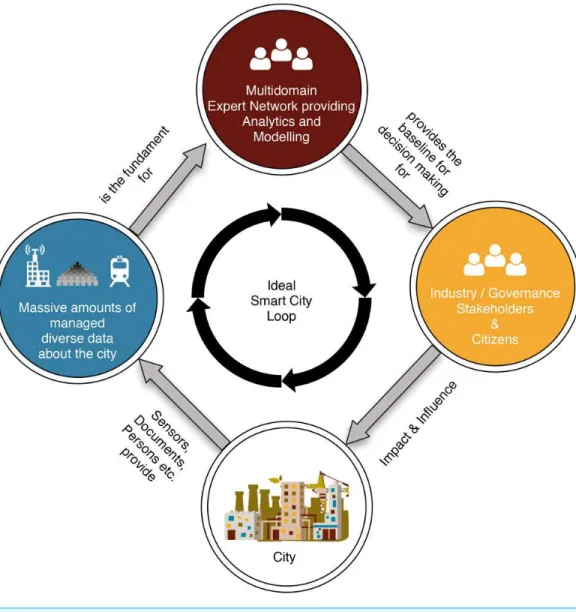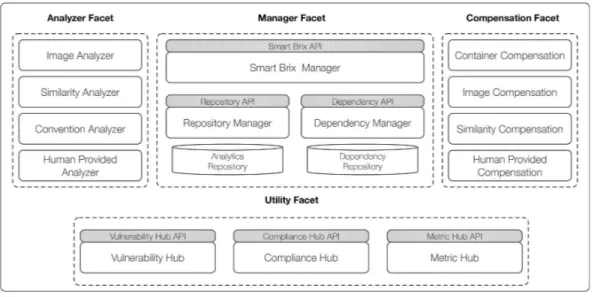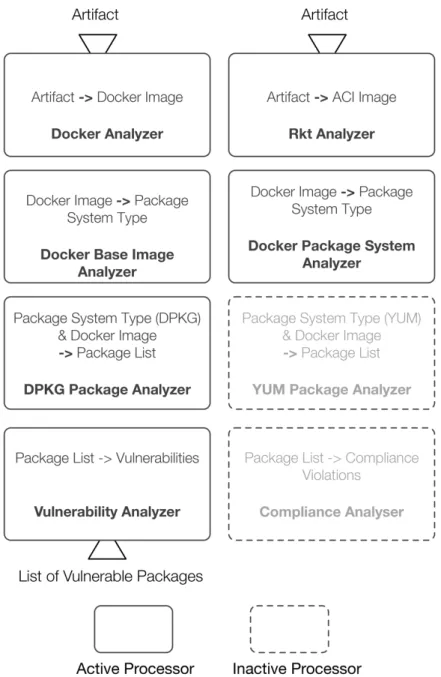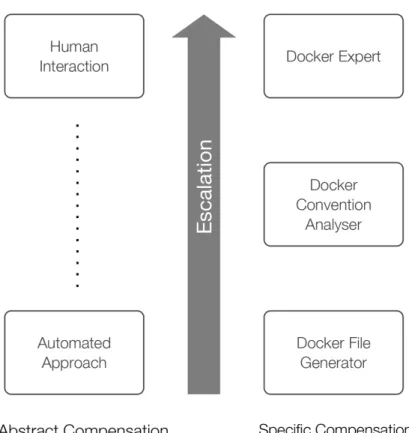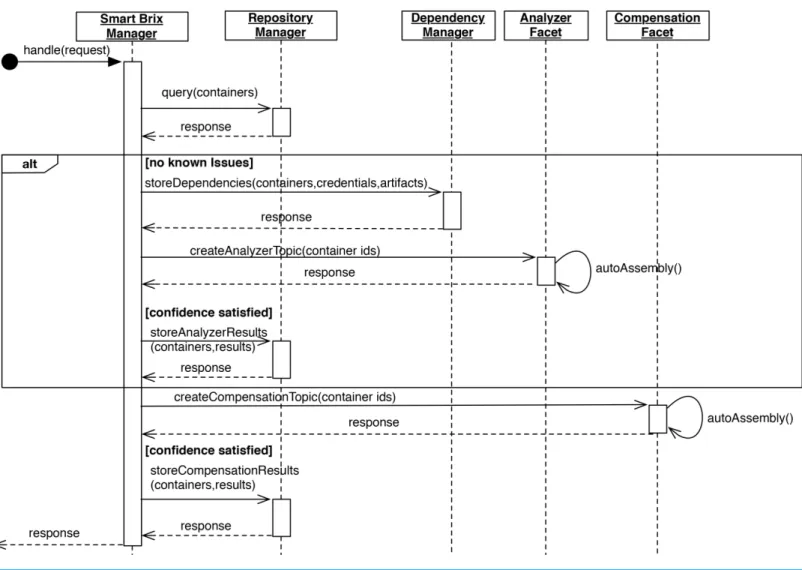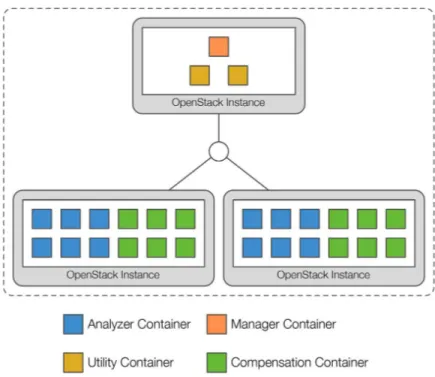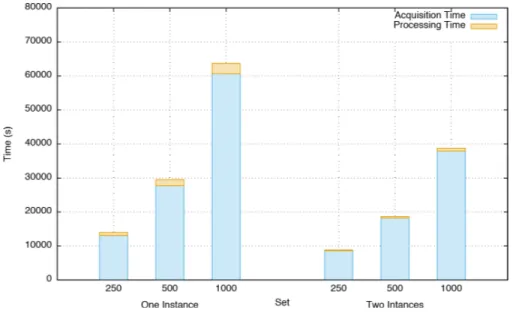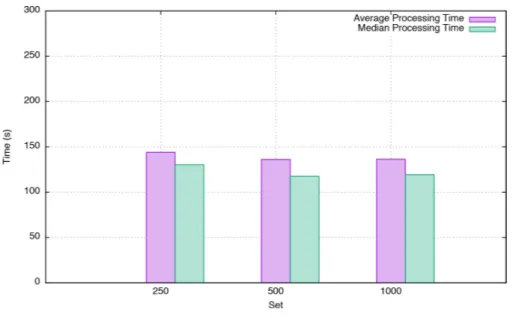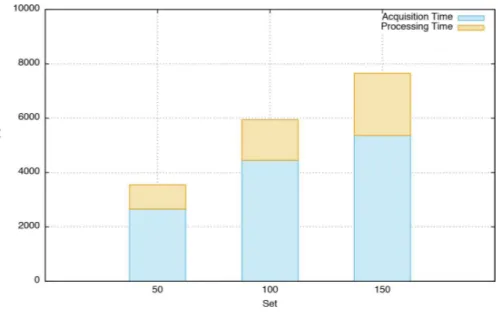Submitted7 March 2016 Accepted 12 May 2016 Published13 June 2016 Corresponding author Johannes M. Schleicher, schleicher@dsg.tuwien.ac.at
Academic editor Elisabetta Di Nitto
Additional Information and Declarations can be found on page 22
DOI10.7717/peerj-cs.66
Copyright 2016 Schleicher et al.
Distributed under
Creative Commons CC-BY 4.0
OPEN ACCESS
Smart Brix—a continuous evolution
framework for container application
deployments
Johannes M. Schleicher1, Michael Vögler1, Christian Inzinger2and
Schahram Dustdar1
1Distributed Systems Group, TU Wien, Vienna, Austria
2S.E.A.L—Software Evolution & Architecture Lab, University of Zürich, Zürich, Switzerland
ABSTRACT
Container-based application deployments have received significant attention in recent years. Operating system virtualization based on containers as a mechanism to deploy and manage complex, large-scale software systems has become a popular mechanism for application deployment and operation. Packaging application components into self-contained artifacts has brought substantial flexibility to developers and operation teams alike. However, this flexibility comes at a price. Practitioners need to respect numerous constraints ranging from security and compliance requirements, to specific regulatory conditions. Fulfilling these requirements is especially challenging in specialized domains with large numbers of stakeholders. Moreover, the rapidly growing number of container images to be managed due to the introduction of new or updated applications and respective components, leads to significant challenges for container management and adaptation. In this paper, we introduce Smart Brix, a framework for continuous evolution of container application deployments that tackles these challenges. Smart Brix integrates and unifies concepts of continuous integration, runtime monitoring, and operational analytics. Furthermore, it allows practitioners to define generic analytics and compensation pipelines composed of self-assembling processing components to autonomously validate and verify containers to be deployed. We illustrate the feasibility of our approach by evaluating our framework using a case study from the smart city domain. We show that Smart Brix is horizontally scalable and runtime of the implemented analysis and compensation pipelines scales linearly with the number of container application packages.
SubjectsAdaptive and Self-Organizing Systems, Distributed and Parallel Computing, Software Engineering
Keywords Containers, Container evolution, Container adaptation, DevOps, Infrastructure as Code
INTRODUCTION
In recent years, we have seen widespread uptake of operating system virtualization based on containers (Soltesz et al., 2007) as a mechanism to deploy and manage complex, large-scale software systems. Using containers, developers create self-contained images of application components along with all dependencies that are then executed in isolation on top of a container runtime (e.g., Docker: https://www.docker.com/, rkt:
application components into self-contained artifacts, developers can ensure that the same artifact is consistently used throughout the complete software release process, from initial testing to the final production deployment. This mechanism for application deployment has become especially popular with practitioners executing projects following DevOps (Hüttermann,2012) principles. Based on the convergence of development and operations, DevOps advocates a high degree of automation throughout the software development lifecycle (e.g., to implement continuous delivery (Humble & Farley,2010)), along with an associated focus on deterministic creation, verification, and deployment of application artifacts using Infrastructure as Code (IaC) (Nelson-Smith,2013) techniques, such as Dock-erfiles(https://docs.docker.com/engine/reference/builder/) for containerized applications. These properties allow for straightforward implementation of immutable infrastructure deployments, as advocated by IaC approaches. Application container images are usually created using a layered structure so that common base functionality can be reused by multiple container images. Application-specific artifacts are layered on top of a base file system so that for subsequent updates only the modified layers need to be transferred among different deployment environments. Container engine vendors such as Docker and CoreOS provide public repositories where practitioners can share and consume container images, both base images for common Linux distributions (e.g., Ubuntu, CoreOS, CentOS, or Alpine) to subsequently add custom functionality, as well as prepared application images that can be directly used in a container deployment. Once uploaded to a repository, a container image is assigned a unique, immutable identifier that can subsequently be used to deterministically deploy the exact same application artifact throughout multiple deployment stages. By deploying each application component in its own container (https://docs.docker.com/engine/articles/dockerfile_best-practices/), practitioners can reliably execute multiple component versions on the same machine without introducing conflicts, as each component is executed in an isolated container.
In this paper, we present Smart Brix, a framework for continuous evolution of container applications. Smart Brix integrates and unifies concepts of continuous integration, runtime monitoring, and operational analytics systems. Practitioners are able to define generic analytics and compensation pipelines composed of self-assembling processing components to autonomously validate and verify containers to be deployed. The framework supports both, traditional mechanisms such as integration tests, as well as custom, business-relevant processes, e.g., to implement security or compliance checks. Smart Brix not only manages the initial deployment of application containers, but is also designed to continuously monitor the complete application deployment topology to allow for timely reactions to changes (e.g., in regulatory frameworks or discovered application vulnerabilities). To enact such reactions to changes in the application environment, developers define analytics and compensation pipelines that will autonomously mitigate problems if possible, but are designed with an escalation mechanism that will eventually request human intervention if automated implementation of a change is not possible. To illustrate the feasibility of our approach we evaluate the Smart Brix framework using a case study from the smart city domain. We show that the runtime of the implemented analysis and compensation pipelines scales linearly with the number of analyzed application packages, and that it adds little overhead compared to container acquisition times.
The remainder of this paper is structured as follows. In ‘Motivation’ we present a motivating scenario and relevant design goals for our framework. We present the Smart Brix framework in ‘The Smart Brix Framework,’ along with a detailed discussion of the framework components. In ‘Evaluation’ we evaluate our approach using a case study from the smart city domain. Related work is discussed in ‘Related Work’, followed by a conclusion and outlook for further research in ‘Conclusion.’
MOTIVATION
In this paper, we base our discussion on a scenario containing a multi-domain expert network as created within URBEM (http://urbem.tuwien.ac.at), a research initiative of the city of Vienna and TU Wien. To tackle the emerging complexities that arise in the smart city domain, we introduced a novel Smart City Loop (Schleicher et al.,2015b), which is depicted inFig. 1. This loop outlines a reactive system that enables stakeholders to make informed decisions based on the models and analyses of interdisciplinary domain experts who in turn can access the large amounts of data provided by smart cities. In URBEM, a network consists of experts in the domains of energy, mobility, mathematics, building physics, sociology, as well as urban and regional planning. URBEM aims to provide decision support for industry stakeholders to plan for the future of the city of Vienna and represents a Distributed Analytical Environment (DAE) (Schleicher et al.,2015c).
Figure 1 Smart City Loop.
developed by companies and research institutes with a large variance in specific versions and requirements to run them. Additionally, these domains have to deal with a broad range of different stakeholders and their specific security and compliance requirements. Models sometimes need to tailor their runtime environment to specific technology stacks to ensure compliance or to be able to access the data they need. Managing and satisfying all these requirements is a non-trivial task and a significant factor hindering broader adoption. Therefore, this environment offers an optimal case for the advantages that come with the use of container-based approaches. Operations teams that need to integrate these models no longer need to be concerned with runtime specifics. Experts simply build containers that can be deployed in the heterogenous infrastructures of participating stakeholders.
stakeholders in the scenario, ranging from research institutions in the City of Vienna to industry stakeholders in the energy and mobility domain. Each of them mandates a very distinct set of security and compliance requirements that need to be met in order to run them. These requirements in turn are subject to frequent changes and the containers need to be able to evolve along with them. Additionally, even though the container approach provides isolation from the host system it is still vital to ensure that the containers themselves are not compromised. This calls for means to check the systems running inside the container for known vulnerabilities, an issue that is subject to heavy and fast-paced change, again requiring according evolution. A recent study ( http://www.banyanops.com/blog/analyzing-docker-hub/) shows that in the case of Docker, depending on the version of the images, more than 70% of the images show potential vulnerabilities, with over 25% of them being severe. This also begs the question of who is responsible for checking and fixing these vulnerabilities, the operations team or the experts who created them? Despite these security and compliance constraints, the ever-changing smart city domain itself makes it necessary for experts to stay on top of the novel toolsets that emerge in order to handle requirements stemming from topics like Big Data or IoT. This leads to a rapid creation and adaptation of models and their according containers, which in turn need be checked against these constraints again. Last but not least, these containers need to comply to certain non-functional requirements that arise from the specific situations they are applied in. This calls for the ability to constantly check containers against certain runtime metrics that need to be met in order to ensure that these systems are able to deliver their excepted results within stakeholder-specific time and resource constraints.
All these factors lead to a complex environment that calls for an ability to easily adapt and evolve containers to their ever-changing requirements. Specifically, we identify the following requirements in the context of our domain:
• The ability to check a large amount of heterogenous containers against an open set of evolving requirements. These requirements can be vulnerabilities, compliance constraints, functional tests, or any other metric of interest for the domain.
• The ability to mitigate issues and evolve these containers based on the results from the previously mentioned checks.
• An approach that is applicable in the context of operations management, while still enabling the participation of experts both for checking as well as evolution.
• An approach that can be applied to existing deployments as well as utilized to test new ones.
THE SMART BRIX FRAMEWORK
Figure 2 Smart Brix framework overview.
Framework rationales
The Smart Brix framework follows the microservice (Newman,2015) architecture paradigm and an overview of the main framework components is shown inFig. 2. The framework is logically organized into four main facets, which group areas of responsibility. Each of these facets is composed of multiple components where each of these components represents a microservice. The components in theAnalyzerandCompensation Facetare managed as self-assembling omponents ( http://techblog.netflix.com/2014/06/building-netflix-playback-with-self.html), an approach we already successfully applied in previous work (Schleicher et al.,2015a). Each of these components follows theCommand Pattern(Gamma et al.,1995) and consists of multiple processorsthat are able to accept multiple inputs and produce exactly one output. This functional approach enables a clean separation of concerns and allows us to decompose complex problems into manageable units.
Figure 3illustrates an example of auto-assembly within theAnalyzer facet. We see a set ofprocessors, where each processor is waiting for a specific type of input and clearly specifies the output it produces. The processors use a message-oriented approach to exchange input and output data, where each output and input is persistently available in the message queue and accessible by any processor. In this example we perform an analysis of a custom-built Debian-based container that hosts the Apache HTTPD server. There are two potential processors for the inputArtifact, each of them able to handle a different container format. Since in our example the Artifact is aDocker Container, only theDocker Analyzer reacts and produces as output aDocker Image. In the next step there are two active processors, the
Figure 3 Example of auto assembling processors within the analyzer facet.
Figure 4 Confidence adaptation model escalation.
Additionally, the components in the analyzer and compensation facets follow the principle ofConfidence Elasticity, which means that a component or processor produces a result that is augmented with a confidence value (c∈R,0≤c≤1), with 0 representing no certainty and 1 representing absolute certainty about the produced result. This allows for the specification of acceptable confidence intervals for the framework, which augment the auto-assembly mechanism. The confidence intervals are provided as optional configuration elements for the framework. In case the provided confidence thresholds are not met, the framework follows an escalation model to find the next component or processor that is able to provide results with higher confidence until it reaches the point where human interaction is necessary to produce a satisfactory result (illustrated inFig. 4). Each processor (pi) from the set of active processors (Pa) provides a confidence valueci. We define the
overall confidence value of all active processors (ca) asca=Q
pi∈Paci. The compensation
stops when cameets the specified confidence interval of the framework or a processor
represents a human interaction which has a confidence value of (ci=1).
Smart Brix Manager
In order to initiate a container evolution, the Smart Brix Manager is invoked via the
Brix Manager queries the Repository Manager to see if there are already known issues for the supplied containers. If any known issues are found, the Smart Brix Manager creates a corresponding compensation topic via the messaging infrastructure by publishing the container identifiers as well as the found issues. This represents an input that will subsequently be consumed by the corresponding Compensation Handlersand starts the previously described auto-assembly process in theCompensation Facet.
If no issues were found, the Smart Brix Manager hands off the suppliedContainers,
CredentialsandArtifactsto theDependency Managerthat is responsible for storing them in theDependency Repository. As a next step, the Smart Brix Manager creates a corresponding analyzer topic via the messaging infrastructure and publishes the container identifiers to it. This generates an input that will be consumed by the correspondingAnalyzers and starts another auto-assembly process in theAnalyzer Facet. The Smart Brix Manager then listens to the created topic and waits for a response from the Analyzer Facet. If any analyzer responds, the manager checks the confidence value of the provided results against the configured confidence interval of the framework. If the results satisfy the interval it uses theRepository API to store them in theAnalytics Repository. If the confidence intervals are not satisfied, it waits for a configured timeout for additional results to emerge. If this fails the framework escalates according to the principle ofConfidence Elasticity and marks the containers as required for human interaction. If the confidence interval was met, the Smart Brix Manager initiates the previously mentioned auto-assembly process in the Compensation Facet. The Smart Brix Manager then listens to the created topic and waits for a response from any compensation handler. In case of a response, it checks the confidence values by applying the same approach as for the Analyzer Facet, and stores them as compensations into the Analytics Repository. A corresponding sequence diagram illustrating this is shown inFig. 5.
Furthermore, the Smart Brix Manager provides API endpoints to query the results of analytics and compensation processes, as well as the current status via container identifiers.
Repository Manager
TheRepository Manager provides a repository for storing analytics results of all analyzed containers as well as their corresponding compensations. The Analytics Repository itself is a distributed key value store that enables Analyzers as well as Compensation Handlers to store information without being bound to a fixed schema. In addition, this enables the previously mentioned open extensibility of our auto-assembly approach by allowing every component to choose the required storage format. Finally, the Repository Manager provides a service interface to store and retrieve analytics and compensation information as well as an interface for querying information based on container identifiers or other attributes.
Dependency Manager
Figure 5 Smart Brix Manager sequence diagram.
Facets to retrieve the necessary credentials and artifacts for the corresponding container IDs. Finally, it acts as service registry for components in theUtility Facetand exposes them to the Compensation and Analyzer Facet. The Dependency Manager uses a distributed key value store for itsDependency Repositoryin order to store the necessary information.
Utility Facet
vulnerability repository. The second component is aCompliance Hubthat allows to check for any compliance violations in the same way the Vulnerability Hub does. This is an important element in heterogenous multi-stakeholder environments, where compliance to all specified criteria must be ensured at all times. The last element is aMetric Hub, which allows to check artifacts for certain relevant metrics in order to ensure relevant Quality of Service constraints for containers.
Analyzers
The task of the components within the Analyzer Facet is to test containers for potential vulnerabilities, compliance violations or any other metrics. The facet is invoked by the
Smart Brix Manager, which triggers an auto-assembly process for the given containers that should be analyzed. The Analyzer Facet can contain components for the most prominent container formats like Docker or Rkt, but due to the fact that we utilize the auto-assembly approach, we are able to integrate new container formats as they emerge. For analyzing a container an analyzer follows three basic steps: (i) Determine the base layer of the container in order to know how to access the package list; (ii) Determine the list of installed packages including their current version; (iii) Match the list of installed packages against a set of vulnerabilities, issues, or compliance constraints in order to determine the set of problems.
Every step can follow a different set of strategies to analyze a container represented as different processors, each of them with a specific confidence value. Possible processors for these steps are: (i) Base Image Processors, which try to determine the base layer of a container by matching their history against known base image IDs; (ii) Similarity Processors that try to select a base layer based on similarities in the history of the container with known containers by performing actions like collaborative filtering and text mining; (iii) Convention Processors that try to determine the base layer by trying common commands and checking their results; (iv) Human Provided Processors, which are human experts that manually analyze a container.
In order to access the containers and to perform analytics, the components within the Analyzer Facet interact with the Dependency Manager. The manager provides them with the necessary credentials for processing containers. Once the analyzers have processed a container, they publish the results, which are augmented with the confidence value, to the corresponding topic where the Smart Brix Manager carries on as previously described.
Compensation Handlers
Again, every step can utilize a set of different processors, each of them with a specific confidence value, which represent different strategies. Possible processors are: (i) Container Processors, which try to use the base image’s package manager to upgrade packages with identified vulnerabilities. (ii) Image Processors that try to build a new image without the vulnerabilities; (iii) Similarity Processor that try to compensate via applying steps from similar containers that do not show these vulnerabilities; (iv) Human Provided Processors, which are human experts that manually compensate a container.
The Compensation Handlers interact with the Dependency Manager in a similar way like the Analyzers to retrieve the necessary credentials to operate. As Image Processors and Similarity Processors build new images in order to compensate, they can request the necessary artifacts associated with an image to be able build them.
Implementation
We created a proof of concept prototype of our framework based on a set of RESTful microservices implemented in Ruby. Each component that exposes a service interface relies on the Sinatra (http://www.sinatrarb.com/) web framework. TheRepository Manager and theDependency Managerutilize MongoDB (https://www.mongodb.org/) as their storage backend, which enables the previously described distributed, open, and extendable key value store for their repositories. We implemented aVulnerability Hubthat uses a SQLite (https: //www.sqlite.org/) storage backend to persist vulnerabilities in a structured format. It holds the recent data from the National Vulnerability Database (NVD; https://nvd.nist.gov/), specifically the listed Common Vulnerabilities and Exposures (CVEs). This CVE Hub allows to import the CVEs posted on NVD, stores them in its repository, and allows to search for CVEs by vulnerable software name as well as version via its Sinatra-based REST interface. To enable the auto-assembly mechanism for each processor within each component in theAnalyzer andCompensation Facet, we use a message-oriented middleware. Specifically, we utilize RabbitMQ’s (https://www.rabbitmq.com/) topic and RPC concepts, by publishing each output and listening for its potential inputs on dedicated topics. We implemented a Docker Analyzer component with aBase Image Processor and aConvention Processor-based strategy. The Docker Analyzer first tries to determine the operating system distribution of the container by analyzing its history. Specifically, it uses the Docker API to generate the history for the container and selects the first layer’s ID, which represents the base layer. It then matches this layer against a set of known layer IDs, which matches corresponding operating system distributions to determine which command to use for extracting the package list. If a match is found, it uses the corresponding commands to determine the package list. If the determined operating system is Ubuntu or Debian, it will usedpkgto determine the package list. If it was CentOS,yumis used, and if it was Alpine,
the known package managers. Based on the results the analyzer determines the distribution flavor and continues as described above.
We further implemented a Docker Compensation Handler with aContainer Processor
and anImage Processor based compensation strategy. The Container Processor tries to upgrade the container using the operating system distribution’s package manager. After this operation succeeds, it checks if the number of vulnerabilities are reduced, by comparing the new version of packages against theCVE Hub. If this was the case it augments the results with a confidence value based on the percentage of fixed vulnerabilities and publishes the results. The Image Processor tries to fix the container by generating a new container manifest (e.g., Dockerfile). More precisely, it uses the Docker API to generate the image history and then derives a Dockerfile from this history. After this step, the Image Processor exchanges the first layer of the Dockerfile with the newest version of its base image. In cases where it cannot uniquely identify the correct Linux flavor, it generates multiple Dockerfiles, for example one for Ubuntu and one for Debian. It then checks the Dockerfiles’ structure for potential external artifacts. Specifically, it searches for anyCOPY orADDcommands that are present in the Dockerfile. If this is the case, it contacts the Dependency Manager and attempts to retrieve the missing artifacts. Once this is finished the Image Processor tries to rebuild the image based on the generated Dockerfile. After this step is finished, the Image Processor again checks the new list of packages against the CVE Hub, and if it could improve the state of the image it publishes the results with the corresponding confidence value. The prototype implementation is available online and can be found at
https://bitbucket.org/jomis/smartbrix/.
Deployment modes
The Smart Brix Framework provides a container for each facet and therefore supports deployment on heterogeneous infrastructures. The framework enables wiring of components and aspects via setting the container’s environment variables, enabling dynamic setups. We distinguish between two fundamental deployment modes,Inspection Mode andIntrospection Mode.
Inspection Mode
TheInspection Mode allows the framework to run in a dedicated inspection and com-pensation setting. In this mode the framework ideally runs exclusively without any other containers and utilizes the full potential of the host systems. This means that the Smart Brix Managers wait until they receive an explicit request to analyze and compensate an artifact.
Introspection Mode
Figure 6 Evaluation Setup of Smart Brix running in inspection mode.
EVALUATION
Setup
For our evaluation we used the following setup. We provisioned three instances in our private OpenStack cloud, each with 7.5 GB of RAM and 4 virtual CPUs. Each of these instances was running Ubuntu 14.04 LTS with Docker staged via docker-machine (https: //docs.docker.com/machine/install-machine/). For our evaluation we choose theinspection deployment variant of our framework in order to stress-test the system without other inter-fering containers. We deployed one manager container representing theManagement Facet, as well as two utility containers containing theCVE Huband theMessaging Infrastructure
on one instance. We then distributed 12 analyzer containers with 12 compensation containers over the remaining two instances. Additionally, we deployed a cAdvisor (https: //github.com/google/cadvisor) container on every instance to monitor the resource usage and performance characteristics of the running containers.Figure 6shows an overview of the deployed evaluation setup.
Experiments
stars), which ensures that we focus on a set with a certain impact. We then extracted the name and the corresponding pull commands along with the latest tag to form the URI of the image. This set of 4,000 URIs represented the source for our experiments, which was then split into 3 sets containing 250, 500, and 1,000 images to be tested.
Analyzer experiments
We started our experiments with a focus on the Analyzer Facet of the framework. First, we started the analyzer containers on one instance and started our tests with the 250 image set. After the run finished we repeated it with the 500 and 1,000 image set. After the tests with one instance, we repeated the experiments with two instances where each run was repeated three times. During the tests we constantly monitored cAdvisor to ensure that the instances were not fully utilized in order to ensure this would not skew results. The focus of our experiments were not the performance characteristics of our framework, in terms of cpu, memory or disk usage, which is why we used cAdvisor only as a monitor to rule out overloading our infrastructure. We also did not utilize any storage backend for cAdvisor since this has shown to be a significant overhead which in turn would have skewed our results.
After the runs had finished we evaluated the vulnerability results. The analyzers logged the analyzed images, their base image flavor (e.g., Ubuntu, Debian etc.), processing time to analyze the image, pull time to get the image from the DockerHub as well as the overall runtime, number of packages, size of the image, and number of vulnerabilities.
Over all our experiments the analyzers showed that around 93% of the analyzed images have vulnerabilities. This mainly stems from the fact that our implemented analyzers have a very high sensitivity and check for any potentially vulnerable software with any potentially vulnerable configuration. However, this does not necessarily mean that the specific combination of software and configuration in place shows the detected vulnerability. If we only take a look at the images with a high severity according to their CVSS (https://nvd.nist.gov/cvss.cfm) score, around 40% show to be affected which is conclusive with recent findings (http://www.banyanops.com/blog/analyzing-docker-hub/). These results underline the importance to implement the measures proposed by our framework. However, the focus of our work and the aim of our experiments was not to demonstrate the accuracy of the implemented vulnerability detection, but the overall characteristics of our framework, which we discuss in the remainder of this section.
Figure 7 Comparison of runtime for analytics between one instance and two instances.
Table 1 Median and standard deviation for processing time per package over all runs with two in-stances.
Set Median processing time Standard deviation processing time No. of packages
250 0.620 s 0.255 s 153,275
500 0.564 s 0.263 s 303,483
1,000 0.537 s 0.252 s 606,721
Overall 0.558 s 0.257 s 1,063,479
approximately 3% of the overall runtime. The fact that the acquisition time for the 1,000 image set does not grow linearly like the runs with the 250 and 500 image set, stems from Docker’s image layer cache. In this case the overall acquisition time grows slower, because a lot of images in the 1,000 set share several layers, which, if already pulled by another analyzer in a previous run, do not need to be pulled again, hence reducing the acquisition time. Finally, we demonstrate that the average processing time of our framework is stable, which is shown in Fig. 8. We further notice a small increase in average processing time for the 250 image set, which is caused by the fact that this set contains more images with larger package numbers compared to the overall amount of images tested, resulting in a slightly higher average processing time. As illustrated inTable 1, per-package processing times remain stable throughout the performed experiments, with a median of 0.558 s and a standard deviation of 0.257 s.
Compensation experiments
Figure 8 Comparison of processing time for analytics with two instances.
no human intervention, has a very high confidence, keeps all artifacts within the images and is therefore optimal to test the auto-compensation ability of our framework. In the process of compensation the Container Processor generates a new image with the upgraded packages. In order to test this image for improvement we have to store it. This means that for every tested image we have to hold the original image as well as its compensated version. Specifically, we choose to test the most vulnerable images (images with the most vulnerable packages) out of the 1,000 image set we tested that are also the most prominent images in our URBEM scenario. This left us with 150 images, which we split in three sets with 50, 100, and 150 images and started our compensation tests. We then repeated each run to demonstrate repeatability and to balance our results. Since the Compensation Facet follows the same principle as the Analyzer Facet we omitted testing it on one instance and immediately started with two instances. After the tests finished, we compared the newly created images to the original ones and checked if the number of vulnerabilities could be reduced.
Overall our experiments showed that from the 150 images we were able to auto-compensate 34 images by reducing the number of vulnerabilities. This illustrates that even a rather simple strategy leads to a significant improvement of around 22.6%, which makes this a very promising approach. In a next step, we compared the overall runtime of our compensation handlers for the three tested sets, and the results are shown inFig. 9. We again can clearly see that the major amount of time is spent for acquisition, in this case pulling the images that need to be compensated. The compensation itself only takes between 24% and 28% of the overall runtime and shows linear characteristics correlating with the number of images to be compensated. The comparatively low increase in acquisition time for the 150 image set again can be explained with the specific characteristics we see in Docker’s layer handling.
Figure 9 Comparison of pulltime and processing time for compensation with two instances.
Figure 10 Comparison of processing time for compensation with two instances.
The average processing time as well as the median processing time are stable. The small increase for the 50 image set is explained with a larger number of images that contain more packages. This fact leads to relatively longer compensation times when upgrading them.
DISCUSSION
Docker Hub, but instead in a local registry, this factor greatly relativizes. The processing time itself scales linearly with the number of analyzed packages, and the same was shown for the compensation approach. Furthermore, the processing time in our current evaluation setup is mostly constrained by the prototypical vulnerability checking mechanism and the chosen storage system, which both are not the focus of our contribution. The implementation of different vulnerability checkers, along with more efficient storage and caching of vulnerability data could lead to further reduction in processing time and will be tackled in future work. An additional aspect we did not specifically address in this paper is the fine-grained scale-out of components in all Smart Brix facets.
Threats to applicability
While the presented framework fulfills the requirements set forth in the previously introduced URBEM project, certain threats to the general applicability of Smart Brix remain.
Currently, the auto-assembly mechanism introduced in ‘Framework rationales’ attempts to eagerly construct analysis and compensation pipelines that are loosely structured along the level of specificity of the performed analysis. Hence, the number of created pipelines can grow exponentially with the number of candidate components in the worst case. If all components for a given level of specificity accept all inputs produced in the previous level, and all subsequent components accept all produced outputs in turn, the number of created pipelines would grow exponentially with the number of components per level of specificity. This problem can be mitigated by introducing a transparent consolidation mechanism that delays the propagation of produced outputs of a certain type for a specified amount of time, orders them by the reported confidence values, and only submits one (or a few) of the produced output values with the highest confidence values for further consumption by other components. Due to the relatively small number of processing components required for the URBEM use case, we left the implementation of this consolidation mechanism for future work.
RELATED WORK
The rapid adoption of container-based execution environments for modern applications enables increased flexibility and fast-paced evolution. Next to this fast-paced evolution of containers, new containers are deployed whenever functionality has to be added, which leads to massive amounts of containers that need to be maintained. While the container provides an abstraction on top of the operating system, it is still vital that the underlying system complies to policies or regulations to avoid vulnerabilities. However, checking the plethora of available environments and adapting them accordingly, is not a trivial task.
et al.(2015) to model based vulnerability testing like the work of Lebeau et al.(2013) as well as automated vulnerability and infrastructure testing methods (e.g., Shahriar & Zulkernine,2009;Hummer et al.,2013).Antunes & Vieira(2013) introduce SOA-Scanner, an extensible tool for testing service-based environments for vulnerabilities. Based on an iterative approach the tool discovers and monitors existing resources, and automatically applies specific testing approaches. Also, more recently, large scale distributed vulnerability testing approaches have been introduced (e.g., Evans, Benameur & Elder,2014;Zhang et al.,2014). In contrast to our approach, the aforementioned tools solely concentrate on testing and identifying possible security threats, but do not provide means for adapting the observed application or its environment accordingly.
More recently, container-based approaches are applied in the literature to ease development and operation of applications. Tosatto, Ruiu & Attanasio(2015) analyze different cloud orchestration approaches based on containers, discuss ongoing research efforts as well as existing solutions. Furthermore, the authors present a broad variety of challenges and issues that emerge in this context.Wettinger, Breitenbücher & Leymann
(2014) present an approach that facilitates container virtualization in order to provide an alternative deployment automation mechanism to convergent approaches that are based on idempotent scripts. By applying action-level compensations, implemented as fine-grained snapshots in the form of containers, the authors showed that this approach is more efficient, more robust, and easier to implement as convergent approaches. However, compared to our approach, the authors do not provide a framework for analyzing container application deployments, which based on identified issues triggers according compensation mechanisms. Gerlach et al. (2014) introduce Skyport, a container-based execution environment for multi-cloud scientific workflows. By employing Docker containers, Skyport is able to address software deployment challenges and deficiencies in resource utilization, which are inherent to existing platforms for executing scientific workflows. In order to show the feasibility of their approach, the authors add Skyport as an extension to an existing platform, and were able to reduce the complexities that arise when providing a suitable execution environment for scientific workflows. In contrast to our approach the authors solely focus on introducing a flexible execution environment, but do not provide a mechanism for continuously evolving container-based deployments.Li, Kanso & Gherbi
(2015) present an approach that leverages Linux containers for achieving high availability of cloud applications. The authors present a middleware that is comprised of agents to enable high availability of Linux containers. In addition, application components are encapsulated inside containers, which makes the deployment of components transparent to the application. This allows monitoring and adapting components deployed in containers without modifying the application itself. Although this work shares similarities with our approach, the authors do not provide a framework for testing container-based deployments, which also supports semi-automatic compensation of found issues.
applications. They are specifically built to make it easy for users to develop and operate the full spectrum of applications, reaching from single container apps, up to distributed microservices stacks. Furthermore, these platforms allow keeping applications secure and up to date, by providing easy patching mechanisms and holistic systems views. In contrast to our approach, these platforms only focus on one specific container technology, and are not extensible. IBM recently introduced the IBM Vulnerability Advisor (https: //developer.ibm.com/bluemix/2015/07/02/vulnerability-advisor/), a tool for discovering possible vulnerabilities and compliance policy problems in IBM containers. While IBM’s approach shares similarities with our work, they are solely focusing on Docker containers that are hosted inside their own Bluemix environment and therefore do not provide a generic approach. Furthermore, their Vulnerability Advisor only provides guidance on how to improve the security of images, but does not support mechanisms to evolve containers.
CONCLUSION
The numerous benefits of container-based solutions have led to a rapid adoption of this paradigm in recent years. The ability to package application components into self-contained artifacts has brought substantial flexibility to developers and operation teams alike. However, to enable this flexibility, practitioners need to respect numerous dynamic security and compliance constraints, as well as manage the rapidly growing number of container images. In order to stay on top of this complexity it is essential to provide means to evolve these containers accordingly. In this paper we presentedSmart Brix, a framework enabling continuous evolution of container application deployments. We described the URBEM scenario as a case study in the smart city context and provided a comprehensive description of its requirements in terms of container evolution. We introduced Smart Brix to address these requirements, described its architecture, and the proof of concept implementation. Smart Brix supports both, traditional continuous integration processes such as integration tests, as well as custom, business-relevant processes, e.g., to implement security, compliance, or other regulatory checks. Furthermore, Smart Brix not only enables the initial management of application container deployments, but is also designed to continuously monitor the complete application deployment topology and allows for timely reaction to changes (e.g., discovered application vulnerabilities). This is achieved using analytics and compensation pipelines that will autonomously detect and mitigate problems if possible, but are also designed with an escalation mechanism that will eventually request human intervention if automated implementation of a change is not possible. We evaluated our framework using a representative case study that clearly showed that the framework is feasible and that we could provide an effective and efficient approach for container evolution.
plan to conduct a large-scale feasibility study of our framework in heterogenous container application deployments.
ADDITIONAL INFORMATION AND DECLARATIONS
Funding
The research leading to these results has received funding from the URBEM doctoral college. The funders had no role in study design, data collection and analysis, decision to publish, or preparation of the manuscript.
Grant Disclosures
The following grant information was disclosed by the authors: URBEM.
Competing Interests
Schahram Dustdar is an Academic Editor for PeerJ.
Author Contributions
• Johannes M. Schleicher conceived and designed the experiments, performed the experiments, analyzed the data, wrote the paper, prepared figures and/or tables, performed the computation work, reviewed drafts of the paper.
• Michael Vögler and Christian Inzinger conceived and designed the experiments, analyzed the data, wrote the paper, prepared figures and/or tables, reviewed drafts of the paper. • Schahram Dustdar wrote the paper, reviewed drafts of the paper.
Data Availability
The following information was supplied regarding data availability:
(1) Source Code Repository for the Prototype Implementation:https://bitbucket.org/ jomis/smartbrix/
(2) The evaluation results:https://bitbucket.org/jomis/smartbrix/downloads/smartbrix_ evaluation_results.zip.
REFERENCES
Antunes N, Vieira M. 2013.SOA-Scanner: an integrated tool to detect vulnerabilities in service-based infrastructures. In:Proceedings of the international conference on services computing. Piscataway: IEEE, 280–287.
Bau J, Bursztein E, Gupta D, Mitchell J. 2010.State of the art: automated black-box web application vulnerability testing. In:Proceedings of the symposium on security and privacy. Piscataway: IEEE, 332–345.
Gamma E, Helm R, Johnson R, Vlissides J. 1995.Design patterns: elements of reusable object-oriented software. Boston: Addison-Wesley Professional.
Gerlach W, Tang W, Keegan K, Harrison T, Wilke A, Bischof J, DSouza M, Devoid S, Murphy-Olson D, Desai N, Meyer F. 2014.Skyport—container-based execution environment management for multi-cloud scientific workflows. In:Proceedings of the international workshop on data-intensive computing in the clouds. Piscataway: IEEE, 25–32.
Humble J, Farley D. 2010.Continuous delivery: reliable software releases through build, test, and deployment automation. 1st edition. Boston: Addison-Wesley Professional.
Hummer W, Rosenberg F, Oliveira F, Eilam T. 2013.Testing idempotence for
infrastructure as code. Lecture notes in computer science, vol. 8275. Berlin Heidelberg: Springer, 368–388.
Hüttermann M. 2012.DevOps for developers. New York: Apress.
Inzinger C, Nastic S, Sehic S, Vögler M, Li F, Dustdar S. 2014.MADCAT—a methodol-ogy for architecture and deployment of cloud application topologies. In:Proc. Intl. Symp. on service-oriented system engineering. Piscataway: IEEE, 13–22.
Lebeau F, Legeard B, Peureux F, Vernotte A. 2013.Model-based vulnerability testing for web applications. In:Proceedings of the international conference on software testing, verification and validation workshops. Piscataway: IEEE, 445–452.
Li R, Abendroth D, Lin X, Guo Y, Baek H-W, Eide E, Ricci R, Van der Merwe J. 2015.
Potassium: penetration testing as a service. In:Proceedings of the symposium on cloud computing. New York: ACM, 30–42.
Li W, Kanso A, Gherbi A. 2015.Leveraging linux containers to achieve high availability for cloud services. In:Proceedings of the international conference on cloud engineering. Piscataway: IEEE, 76–83.
Li H-C, Liang P-H, Yang J-M, Chen S-J. 2010.Analysis on cloud-based security vul-nerability assessment. In:Proceedings of the international conference on E-business engineering. Piscataway: IEEE, 490–494.
Lowis L, Accorsi R. 2009.On a classification approach for SOA vulnerabilities. In:
Proceedings of the international computer software and applications conference. Piscataway: IEEE, 439–444.
Lowis L, Accorsi R. 2011.Vulnerability analysis in SOA-based business processes.IEEE Transactions on Services Computing 4(3):230–242 DOI 10.1109/TSC.2010.37.
Nelson-Smith S. 2013.Test-driven infrastructure with chef. 2nd edition. North Se-bastopol: O’Reilly Media.
Newman S. 2015.Building microservices. North Sebastopol: O’Reilly Media, Inc.
Schleicher JM, Vögler M, Inzinger C, Dustdar S. 2015a.Smart fabric-an infrastructure-agnostic artifact topology deployment framework. In:Proceedings of the international conference on mobile services. Piscataway: IEEE, 320–327.
Schleicher JM, Vögler M, Inzinger C, Hummer W, Dustdar S. 2015c.Nomads— enabling distributed analytical service environments for the smart city domain. In:
Proceedings of the international conference on web services. Piscataway: IEEE, 679–685.
Shahriar H, Zulkernine M. 2009. Automatic testing of program security vulnerabilities. In: Proceedings of the international computer software and applications conference, vol. 2. Piscataway: IEEE, 550–555.
Soltesz S, Pötzl H, Fiuczynski ME, Bavier A, Peterson L. 2007.Container-based oper-ating system virtualization: a scalable, high-performance alternative to hypervisors.
SIGOPS Operating Systems Review41(3):275–287 DOI 10.1145/1272998.1273025.
Tosatto A, Ruiu P, Attanasio A. 2015.Container-based orchestration in cloud: state of the art and challenges. In:Proceedings of the international conference on complex, intelligent, and software intensive systems. Piscataway: IEEE, 70–75.
Vögler M, Schleicher JM, Inzinger C, Dustdar S. 2015a.Diane—dynamic iot application deployment. In:Proceedings of the international conference on mobile services.
Piscataway: IEEE, 298–305.
Vögler M, Schleicher JM, Inzinger C, Nastic S, Sehic S, Dustdar S. 2015b.LEONORE— large-scale provisioning of resource-constrained IoT deployments. In:Proceedings of the international symposium on service-oriented system engineering. Piscataway: IEEE, 78–87.
Wettinger J, Breitenbücher U, Leymann F. 2014.Compensation-based vs. convergent deployment automation for services operated in the cloud.Lecture Notes in Computer Science8831:336–350DOI 10.1007/978-3-662-45391-9_23.
Yu W, Aravind D, Supthaweesuk P. 2006.Software vulnerability analysis for web services software systems. In:Proceedings of the symposium on computers and communications. Piscataway: IEEE, 740–748.
